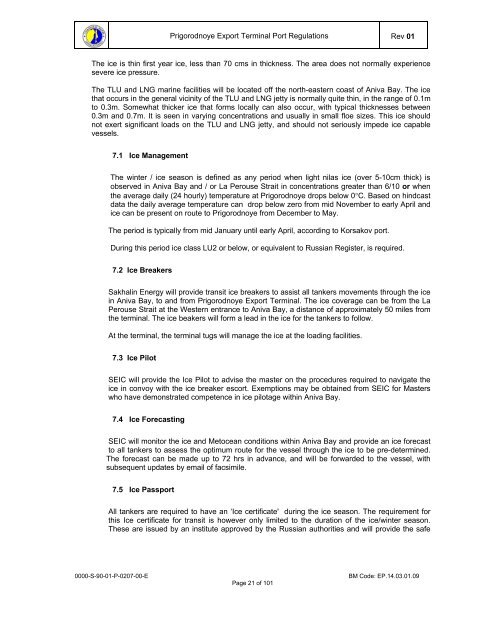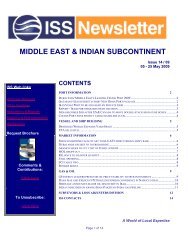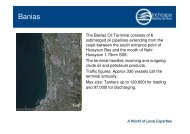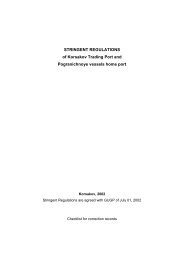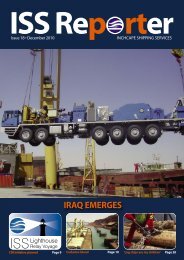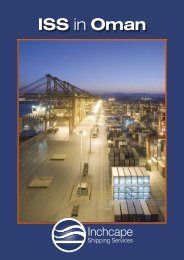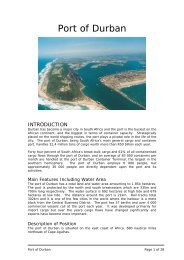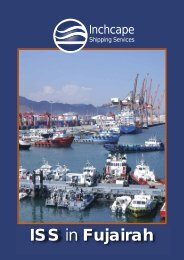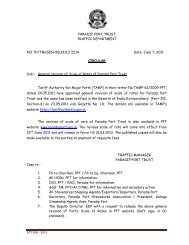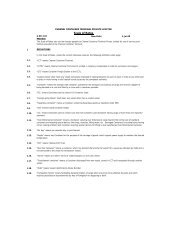Prigorodnoye Export Terminal Port Regulations.pdf - Inchcape ...
Prigorodnoye Export Terminal Port Regulations.pdf - Inchcape ...
Prigorodnoye Export Terminal Port Regulations.pdf - Inchcape ...
You also want an ePaper? Increase the reach of your titles
YUMPU automatically turns print PDFs into web optimized ePapers that Google loves.
<strong>Prigorodnoye</strong> <strong>Export</strong> <strong>Terminal</strong> <strong>Port</strong> <strong>Regulations</strong> Rev 01<br />
The ice is thin first year ice, less than 70 cms in thickness. The area does not normally experience<br />
severe ice pressure.<br />
The TLU and LNG marine facilities will be located off the north-eastern coast of Aniva Bay. The ice<br />
that occurs in the general vicinity of the TLU and LNG jetty is normally quite thin, in the range of 0.1m<br />
to 0.3m. Somewhat thicker ice that forms locally can also occur, with typical thicknesses between<br />
0.3m and 0.7m. It is seen in varying concentrations and usually in small floe sizes. This ice should<br />
not exert significant loads on the TLU and LNG jetty, and should not seriously impede ice capable<br />
vessels.<br />
7.1 Ice Management<br />
The winter / ice season is defined as any period when light nilas ice (over 5-10cm thick) is<br />
observed in Aniva Bay and / or La Perouse Strait in concentrations greater than 6/10 or when<br />
the average daily (24 hourly) temperature at <strong>Prigorodnoye</strong> drops below 0°C. Based on hindcast<br />
data the daily average temperature can drop below zero from mid November to early April and<br />
ice can be present on route to <strong>Prigorodnoye</strong> from December to May.<br />
The period is typically from mid January until early April, according to Korsakov port.<br />
During this period ice class LU2 or below, or equivalent to Russian Register, is required.<br />
7.2 Ice Breakers<br />
Sakhalin Energy will provide transit ice breakers to assist all tankers movements through the ice<br />
in Aniva Bay, to and from <strong>Prigorodnoye</strong> <strong>Export</strong> <strong>Terminal</strong>. The ice coverage can be from the La<br />
Perouse Strait at the Western entrance to Aniva Bay, a distance of approximately 50 miles from<br />
the terminal. The ice beakers will form a lead in the ice for the tankers to follow.<br />
At the terminal, the terminal tugs will manage the ice at the loading facilities.<br />
7.3 Ice Pilot<br />
SEIC will provide the Ice Pilot to advise the master on the procedures required to navigate the<br />
ice in convoy with the ice breaker escort. Exemptions may be obtained from SEIC for Masters<br />
who have demonstrated competence in ice pilotage within Aniva Bay.<br />
7.4 Ice Forecasting<br />
SEIC will monitor the ice and Metocean conditions within Aniva Bay and provide an ice forecast<br />
to all tankers to assess the optimum route for the vessel through the ice to be pre-determined.<br />
The forecast can be made up to 72 hrs in advance, and will be forwarded to the vessel, with<br />
subsequent updates by email of facsimile.<br />
7.5 Ice Passport<br />
All tankers are required to have an ‘Ice certificate' during the ice season. The requirement for<br />
this Ice certificate for transit is however only limited to the duration of the ice/winter season.<br />
These are issued by an institute approved by the Russian authorities and will provide the safe<br />
0000-S-90-01-P-0207-00-E<br />
Page 21 of 101<br />
BM Code: EP.14.03.01.09


